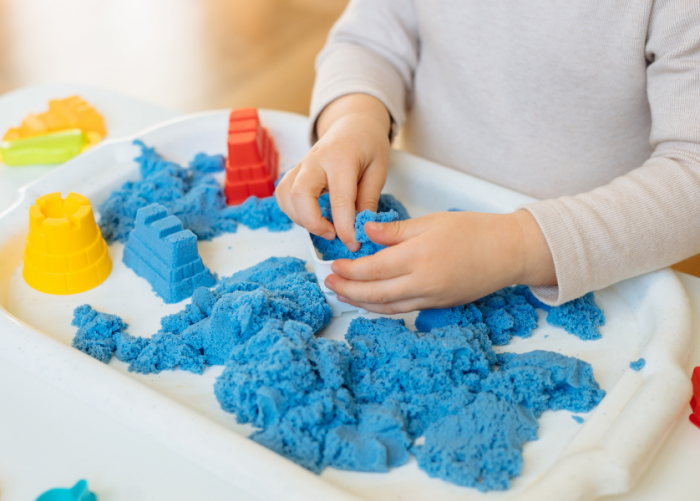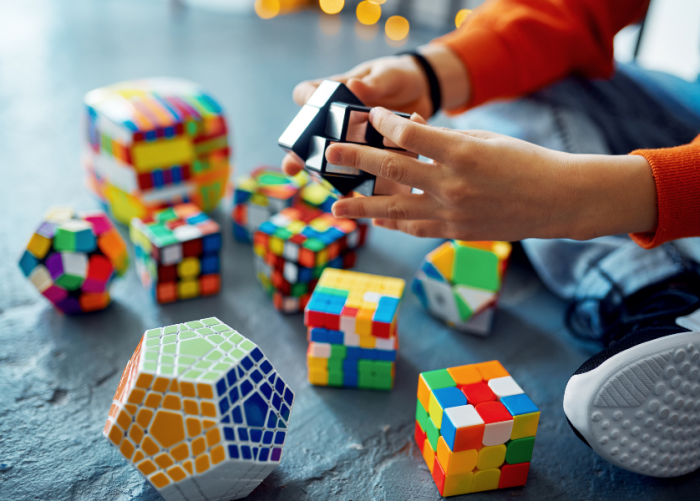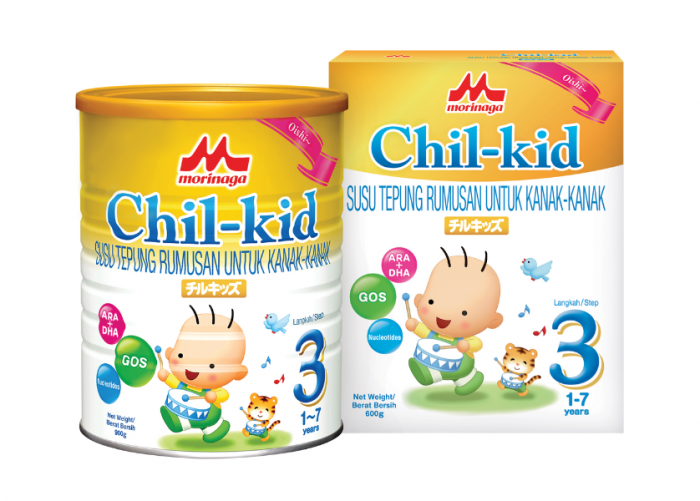What is memory? In simple terms it is the process of taking in information, processing it, storing it and later ─ sometimes many years later ─ retrieving that information for the purpose of influencing future action. This is why human memory is often likened to that of a computer memory system or a filing cabinet.
There are three types of memory[1]:
1: Sensory Memory
2: Short-term Memory or Working Memory
3: Long-term Memory
Sensory Memory
 In human memory, Sensory Memory[2] is the first stage of the memory system. This is where young children, beginning from the age of two, use all their senses to explore their world. Everything they feel, hear, see, touch or taste are filed away as sensory experiences in their sensory memory. They then use this Sensory emory[3] to begin the process of understanding and gaining knowledge of the world around them.
In human memory, Sensory Memory[2] is the first stage of the memory system. This is where young children, beginning from the age of two, use all their senses to explore their world. Everything they feel, hear, see, touch or taste are filed away as sensory experiences in their sensory memory. They then use this Sensory emory[3] to begin the process of understanding and gaining knowledge of the world around them.
Working or Short-term Memory
Working Memory or Short-term Memory is the second stage of the memory system. This is the part of memory that requires conscious effort and paying adequate attention to execute the task. Young children often struggle with many aspects of attention. That is why they are said to have short attention spans. But it is not because there’s something wrong. The amount of information he can hold at any one time is much smaller than that of an older child or adults. For example, an adult or teenager can remember a seven-digit number effortlessly while a five-year-old can only remember a four–digit number. The teenager will be able to multi-task while the five-year-old may struggle to complete a single task especially if he gets distracted in between. You might even wonder why or worry that he seems to be so forgetful and you might hear yourself saying:
“But we just went through that lesson yesterday!”
“How many times do I have to repeat myself?”
“Can you please focus?”
Don’t worry. As the brain matures, his cognitive function and Working Memory will improve.
Long-term Memory
The third component in memory is Long-term Memory, which is also known as Permanent Memory. An example would be learning how to walk or hold a pencil to write or swim or cycle even if you have not done these activities for a long time. Another example of Long-term Memory is the recollection of facts or events that happened a long time ago that we can consciously call up.
IQ and Working Memory
Children need to use Working Memory in order to learn, apply these lessons to problem solve, develop their cognitive skills, perform tasks and do better in school. For instance, they need to remember the letters needed in a word in order to pronounce, spell and write correctly or remember numbers, how to count, add, subtract or multiply in order to understand mathematics.
This is why there is a strong correlation between Working Memory and Intelligence[4]. When people perform better on a Working Memory task, they also tend to perform better on an intelligence task.
For example, when we perform a mental calculation such as 5+12-7X2=20, we need to remember the numbers in our head as we carry out the calculation. It is therefore not surprising that children who do better on Working Memory tasks also score higher on math, language, reasoning and intelligence tests. Working Memory develops from early childhood till young adulthood. Naturally, the more developed Working Memory becomes, the higher the IQ of the child.
You can help your child improve his Working Memory with these simple strategies:
1: Work on Visualisation[5] Skills
 After reading or hearing about an event, tell your child to paint a picture of the scene in his mind. For example, say you’ve told your child to set the table for five people. Have your child imagine what the table should look like and then draw it. As children get better at language and visualisation, have him describe the scene to you instead of drawing it.
After reading or hearing about an event, tell your child to paint a picture of the scene in his mind. For example, say you’ve told your child to set the table for five people. Have your child imagine what the table should look like and then draw it. As children get better at language and visualisation, have him describe the scene to you instead of drawing it.
Games that mix and match items can also improve visual memory and flash cards that have words or images also help him to remember word meanings.
2: Take a Multisensory Approach[6]
Try to utilise all his senses when teaching him about something. For instance, if you are teaching him about apples, try not to stick to just reading about the apple. Give him a real apple to touch, smell, taste and even learn about the colours on the apple (which could range from yellow to red or green) and count the number of seeds inside. By giving your child a chance to process information through sight, sound, touch and taste, they can achieve better memory attention.
3: Change Up[7] the Setting
It’s good to be consistent when studying but who says that studying must only occur at the same time and place, using the same desk and even the same pen? Doing something different now and then can make the moment more interesting, the memory richer and the lesson easier to recollect in the future. You can help your child encode the memory of their study time by taking him to a bistro to do his homework while you and he enjoy a slice of cake for instance, or allow him to listen to music for part of his study time or invite his classmates over to study together or even simply go to another part of the house to study. Any small change will have a huge benefit to learning.
4: Have Your Child Teach You[8]
 You don’t have to be the teacher all the time. Tell your child to teach you instead. He will have to explain the information he is learning which will make him think, make sense of the information and describe and show how he is doing the task. Maybe your child is learning to play a musical instrument, or paint a picture or play a sport. Asking him to teach you will help him recall all the components of the project and discuss with you how and why he is doing it a certain way.
You don’t have to be the teacher all the time. Tell your child to teach you instead. He will have to explain the information he is learning which will make him think, make sense of the information and describe and show how he is doing the task. Maybe your child is learning to play a musical instrument, or paint a picture or play a sport. Asking him to teach you will help him recall all the components of the project and discuss with you how and why he is doing it a certain way.
5: Encourage Active Learning[9] by Asking Him Questions
Make learning more engaging by having discussions about different topics and then ask your child what he thinks. Say, the family has just watched a movie together. Afterwards, ask him about what he liked or disliked about the movie and what he thinks of it. This will encourage him to remember and review the movie he has just seen to answer your question. It will also help him develop critical thinking skills while improving his memory power.
6: Encourage Him to Ask Questions
Understanding a subject is the first step to being able to remember the lesson. Encourage your child to ask questions to help ensue he understands what he has learnt. This will also help your child develop critical thinking and problem-solving skills.
7: Make Connections[10] of Experiences
When learning about different modes of transportation for instance, draw from personal experiences to help your child create a stronger memory. For example, you can talk about the trip you last had together and all the different modes of transportation you took such as the aeroplane, car, bus, ferry, LRT, MRT and so on. This way your child will associate fun with the lesson he is learning and have a higher probability of remembering all the names of the different vehicles and types of transportation he rode in.
8: Create Patterns, Rhymes and Songs[11]
Isn’t it always easier to remember things in a song? Remember the tune “ABCDEFG”? You remember it to this day even though you learnt it many years ago. Our brains are wired to remember music, rhyme and patterns, so using music or rhyme and patterns can help your child improve his memory and recall.
9: Make Learning Exciting[12]
Encourage your child’s enthusiasm for learning by taking him to a science centre, or cultural centre or museum. If your child is interested in the subject matter, it will be easier to remember it in the future.
10: Don’t forget Nutrition, the Most Important Memory Booster
In all this discussion about strategies to boost memory power, the most important one of all is actually nutrition. Nutrition is essential in aiding the development of children’s brains and it plays a key role in helping them focus, concentrate, absorb, retain and call up information whenever needed to perform a task. Memory and the brain are thus very much linked. Feed the brain well to boost its health and memory power will automatically follow.
So, how does one maximise memory power and brain health through food? Is there a recipe for it?
Apparently there is, and research[13] suggests eating a healthy selection of dietary fats and an array of plant foods rich in phytonutrients. Eating low glycemic index (GI) foods[14] can also support brain function as they balance blood sugar and improve the child’s concentration and focus while studying.
However, long before the child sets foot in a classroom, his brain would have needed the right nutrients for its development. According to this study on The Role of Nutrition in Brain Development: The Golden Opportunity of the First 1000 Days[15], a huge portion of the brain’s ultimate structure and capacity is shaped by the time a child reaches the age of three[16]. All nutrients are necessary for brain growth and function but the following nutrients are extra essential for his early cognitive, behavioural and overall physical development:
Nutrients Needed for Early Child Development
 Protein[17] ─ a major component of the skin, muscle, bone, organs, hair and nails. These long chain amino acids are needed to build, repair cells, tissues and regulate blood clotting, fluid balance, immune system responses, vision, hormones and enzymes.
Protein[17] ─ a major component of the skin, muscle, bone, organs, hair and nails. These long chain amino acids are needed to build, repair cells, tissues and regulate blood clotting, fluid balance, immune system responses, vision, hormones and enzymes.
Carbohydrates[18] ─ are the sugars, starches and dietary fibre from plant foods and dairy products that provide energy for the body to function and grow.
Long Chain Polyunsaturated Fatty Acids[19] (LCPs) ─ are important for nerve function and brain health. There are several types of LCPs, primarily Omega 3 and Omega-6 fatty acids. Omega-3 is needed for the functioning of the body’s cells and plays an important role in the heart, lungs, blood vessels and immune system. The three main types of Omega-3 are Eicosapentaenoic acid (EPA), Docosahexaenoic acid (DHA), and Alpha-linolenic acid (ALA). Several studies have found a link between Omega-3 consumption and better brain health.
Choline[20] ─ a nutrient that supports various bodily functions including cell maintenance and growth, DNA synthesis along with other nutrients such as Folic Acid and Vitamin B-12, nervous system functioning, breathing and heart rate regulation and metabolism.
Iron[21] ─ a mineral vital for the production of haemoglobin, a protein needed to transport oxygen in the blood.
Copper[22] ─ an essential trace mineral found in all body tissues and plays a role in making red blood cells, maintaining nerve cells and the immune system.
Zinc[23] ─ a mineral that supports the immune system, contributes to wound healing, and plays a role in childhood growth and development.
B Vitamins[24] ─ are a group of eight essential nutrients that support many organs and bodily systems. Vitamins B12, B6, B3 and B9 also known as Folic Acid or Folate help produce the energy needed to develop new brain cells[25] and synapses, impact energy levels and metabolism, increase alertness and concentration, decrease anxiety as well as produce blood cells and maintain healthy skin.
Vitamin B12[26] in particular, has been said to improve memory, make learning new things easier and can improve mood and lessen depressive symptoms. Conversely, a Vitamin B deficiency[27] has been linked to irritability, fatique and hyperactivity in children.
Vitamin C[28] ─ a vital nutrient that helps form and maintain bones, skin, blood vessels and form neurotransmitters. It also helps the body absorb iron, strengthens the immune system and enhances wound healing.
Vitamin D[29] ─ essential for bone and teeth strength and regulates inflammation and immune function.
Iodine[30] ─ a mineral that is needed to ensure the thyroid works properly. Thyroid hormones regulate a wide range of bodily functions including metabolism, bone health, immune response and development of the central nervous system.
Selenium[31] ─ a trace mineral that improves cognition, immune system function and fertility while protecting the body from oxidative damage and infection.
When the child has begun joining the dinner table to eat adult food, giving him diets rich in fruits, vegetables, whole grains and legumes, fish, healthy fats and herbs or seeds can boost brain and memory function.
Brain & Memory Boosting Foods for Children
 Eggs[32] ─ Brain boosting nutrients in eggs include choline, Vitamin B12 and protein.
Eggs[32] ─ Brain boosting nutrients in eggs include choline, Vitamin B12 and protein.
Fatty Fish and Seafood[33] ─ Salmon is a good example of fatty fish. Other seafood options include prawns (check for allergy), Tilapia, Crab or Cod. Fatty fish and seafood are excellent sources of Omega-3 fatty acids like DHA and EPA as well as protein, zinc, iron, choline and iodine.
Peanut Butter[34] ─ Rich in Vitamin E and a potent antioxidant that protects nervous membranes. It also has thiamine (Vitamin B1) to help the brain and nervous system to use glucose for energy.
Whole Grains[35] ─ The brain needs a constant supply of glucose for energy to function. Whole grains also have B-Vitamins to nourish the nervous system.
Colourful and Leafy Green Vegetables[36] ─ Tomatoes, sweet potatoes, pumpkin, carrots and all those vegetables with deep, rich colour are the best sources of antioxidants such as beta carotene, Vitamin C, and Vitamin E that keep the brain sharp. Leafy green vegetables are a great source of iron and folate. Children who get enough folate tend to have better cognition than those who don’t and iron plays an important role in the development of the hippocampus ─ the part of the brain responsible for learning and memory.
Beans[37] ─ Beans contain a high amount of zinc. They also contain fibre and protein. White pea and kidney beans further contain ALA Omega-3 fatty acids.
Lentils[38] ─ Lentils are packed with B Vitamins especially folate which boosts cognitive performance. These legumes also contain iron, magnesium, potassium and zinc.
Milk and Yoghurt[39] ─ Dairy foods are packed with protein and B-Vitamins ─ essential for the growth of brain tissue, neurotransmitters and enzymes. Dairy foods also contain calcium and Vitamin D, a nutrient that benefits the neuromuscular system and the body’s cells. Additionally, yoghurt also has the benefit of good live bacteria such as Lactobacillus bulgaricus and Streptococcus thermophiles which are important for gut health.
Berries[40] ─ Berries contain antioxidant properties that can boost the brain, learning and memory retention. Berries also contain flavonoids and beneficial plant compounds called anthocyanins that help increase blood flow to the brain as well as promote the production of new nerve cells.
Lean Beef[41] ─ Lean beef is brain food because it contains iron, the mineral that helps children stay energised and focus in school. Lean beef is one of the best absorbed sources of iron[42]. Just 1 ounce per day has been shown to help the body absorb iron. Beef also contains zinc which helps with memory.
Morinaga Chil-kid
 Morinaga Chi-kid is growing-up milk that has been specially formulated to complement a growing child’s nutritional needs. Made for Asian children aged one to seven, the milk is packed with 45 essential nutrients including ARA, DHA, Omega 3&6 LCPs, Protein, Vitamins and Minerals such as the Vitamins B1, B3, B6, B9, B12, Vitamins A, C, D, E, K1, calcium, iron, choline, calcium, zinc, selenium as well as Nucleotides and GOS dietary fibre.
Morinaga Chi-kid is growing-up milk that has been specially formulated to complement a growing child’s nutritional needs. Made for Asian children aged one to seven, the milk is packed with 45 essential nutrients including ARA, DHA, Omega 3&6 LCPs, Protein, Vitamins and Minerals such as the Vitamins B1, B3, B6, B9, B12, Vitamins A, C, D, E, K1, calcium, iron, choline, calcium, zinc, selenium as well as Nucleotides and GOS dietary fibre.
A Japanese formulation with over 100-plus years of Morinaga R&D, the milk comes from dairy cows in the Netherlands where it is packed under stringent quality control with double inspection process before the product is exported to Malaysia.
To find out more about Morinaga Chil-kid, click here.

 In human memory,
In human memory,  After reading or hearing about an event, tell your child to paint a picture of the scene in his mind. For example, say you’ve told your child to set the table for five people. Have your child imagine what the table should look like and then draw it. As children get better at language and visualisation, have him describe the scene to you instead of drawing it.
After reading or hearing about an event, tell your child to paint a picture of the scene in his mind. For example, say you’ve told your child to set the table for five people. Have your child imagine what the table should look like and then draw it. As children get better at language and visualisation, have him describe the scene to you instead of drawing it. 


 Morinaga Chi-kid is growing-up milk that has been specially formulated to complement a growing child’s nutritional needs. Made for Asian children aged one to seven, the milk is packed with 45 essential nutrients including ARA, DHA, Omega 3&6 LCPs, Protein, Vitamins and Minerals such as the Vitamins B1, B3, B6, B9, B12, Vitamins A, C, D, E, K1, calcium, iron, choline, calcium, zinc, selenium as well as Nucleotides and GOS dietary fibre.
Morinaga Chi-kid is growing-up milk that has been specially formulated to complement a growing child’s nutritional needs. Made for Asian children aged one to seven, the milk is packed with 45 essential nutrients including ARA, DHA, Omega 3&6 LCPs, Protein, Vitamins and Minerals such as the Vitamins B1, B3, B6, B9, B12, Vitamins A, C, D, E, K1, calcium, iron, choline, calcium, zinc, selenium as well as Nucleotides and GOS dietary fibre.